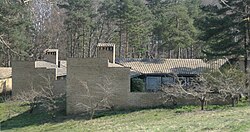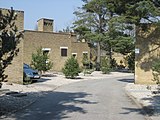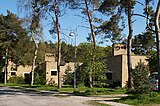| Kingo Houses | |
|---|---|
 | |
| General information | |
| Architectural style | Modernism |
| Town or city | Helsingør |
| Country | Denmark |
| Construction started | 1956 |
| Completed | 1958 |
| Technical details | |
| Structural system | Masonry |
| Design and construction | |
| Architect(s) | Jørn Utzon |
Kingo Houses is a housing development designed by architect Jørn Utzon in Helsingør, Denmark. The development consists of 60 L-shaped houses based upon the design of traditional Danish farmhouses with central courtyards and those of Chinese and Islamic dwellings.
History
The design of the Kingo Houses was based on a competition project Utzon had developed for the south of Sweden in 1953. Although he did not obtain a commission in Sweden, the mayor of Helsingør liked his idea and provided land for Utzon to realize his project.
Named after the developer Boligselskabet Kingo, the housing is currently known as Romerhusene (English: Roman houses).
Design
The development is based on Utzon's additive approach, starting modestly with one unit and proceeding from there, taking into account the lie of the land and the surroundings. Utzon described the arrangement of the houses as "flowers on the branch of a cherry tree, each turning towards the sun."
Each unit has an area of 15 by 15 metres (49 ft × 49 ft), enclosed on two sides by the L-shaped house, and by walls on the other two sides. The small size of the units makes them not only economical but also easily adaptable to the natural terrain. The limited size of the private area is compensated by the provision of a large landscaped communal space. Each house has a courtyard with two wings, one for living, the other for sleeping. Utzon set the exact amount of bricks to be used for the courtyard walls but he told the bricklayers they should build each house individually, catering for privacy, shade, view and enclosure. Built with state funding, the houses were limited to 104 m (1,120 sq ft) per three-bed unit.
Influence
Utzon drew inspiration for the Kingo Houses from traditional Nordic architectural sensibilities. The design of the dwellings were predicated on traditional Danish vernacular farmhouses. Furthermore, their design formed a prototype for Utzon's second courtyard housing project, the Fredensborg Houses. They have been called the finest Scandinavian example of humane housing.
References
- ^ John Pardey: "Poetry from materials – Jørn Utzon’s brickwork beginnings" in Brick Bulletin, Spring 2009 Archived 2012-04-02 at the Wayback Machine. Retrieved 24 September 2011.
- ^ "Jørn Utzon, 2003 laureate, Biography" Archived 2010-12-22 at the Wayback Machine, PritzkerPrize.com. Retrieved 25 September 2011.
- Romerhusene, (in Danish), Retrieved 17 September 2011.
- Møller, Henrik Sten and Udsen, Vibe: Jørn Utzon Houses, Living Architecture Publishing, Copenhagen, ISBN 87-987597-3-6
- Frampton, Kenneth (2007). Modern Architecture: A Critical History. London: Thames and Hudson. p. 314.
- Adrian Carter, "Between Earth and Sky: The work of Jørn Utzon, as an exemplary phenomenological approach to modern architecture made concrete". Retrieved 25 September 2011.
External links
| Helsingør Municipality | |||||||
|---|---|---|---|---|---|---|---|
| Districts, towns and villages |
| ||||||
| Nature, parks and open spaces | |||||||
| Culture and attractions | |||||||
| Other landmarks |
| ||||||
| Transportation |
| ||||||
| History | |||||||
| Jørn Utzon | |
|---|---|
| Australia and Middle East | |
| Denmark and Sweden | |
| Spain | |
| Concepts | |
| Related | |
56°1′55.59″N 12°34′42.4″E / 56.0321083°N 12.578444°E / 56.0321083; 12.578444
Categories:


